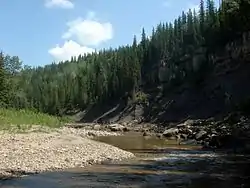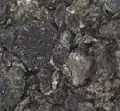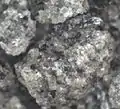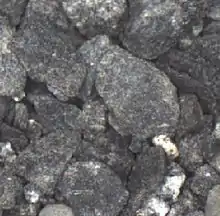Smoky Group
The Smoky Group is a stratigraphical unit of Late Cretaceous age in the Western Canadian Sedimentary Basin.
| Smoky Group Stratigraphic range: Late Cretaceous | |
|---|---|
 Kaskapau Shale exposed along the Pouce Coupe River | |
| Type | Geological formation |
| Sub-units | Puskwaskau Formation Bad Heart Formation Kaskapau Formation |
| Underlies | Wapiti Group |
| Overlies | Dunvegan Formation |
| Thickness | up to 1,100 feet (340 m)[1] |
| Lithology | |
| Primary | Shale, sandstone, siltstone |
| Location | |
| Region | |
| Country | |
| Type section | |
| Named for | Smoky River |
| Named by | George Mercer Dawson, 1881. |
It takes the name from the Smoky River, and was first described in outcrops along the banks of the Smoky River, Spirit River and Pouce Coupe Rivers by George Mercer Dawson in 1881.[2]
Lithology
The Smoky Group is represented by marine silty shale with ironstone and bentonite streaks. Sandstone occurs at the base, and is transitional to the Dunvegan Formation.[1]
Hydrocarbon production
Gas is produced from the Cardium Formation in the southern reaches of the Group, in central Alberta and northern Alberta.
Distribution
The Kaskapau Shale reaches 477m in the Pouce Coupe River area and thins towards the east in the Smoky River area. The Bad Heart Formation sandstone is up to 8m thick, while the Puskwaskau Formation ranges from 200m in the Pouce Coupe Prairie to 123m in the Spirit River area. The entire group measures up to 677 m (2,220 ft) in the Pouce Coupe Prairie, and can reach 1,100 m (3,610 ft) in the Canadian Rockies foothills of northeast British Columbia.[1]
Relationship to other units
The Smoky Group is conformably and transgressively followed by the Wapiti Group and rests conformably on the Dunvegan Formation sandstone. The Cardium sandstone and Muskiki shale are replacing the upper parts of the Kaskapau Formation in the south-east of the distribution area. The entire group correlates with the Blackstone Formation, Cardium Formation and Wapiabi Formation of the Alberta Group in the southern foothills. The equivalent stratigraphic sequence in central Alberta consists of the Lea Park Formation and the upper Colorado Group, in north-eastern Alberta it correlates with Labiche Formation, and with the Kotaneelee Formation in the Liard River area.[1]
Subdivisions
The Smoky Group has the following sub-divisions from top to bottom:
| Sub-unit | Age | Lithology | Max. Thickness | Reference |
|---|---|---|---|---|
| Puskwaskau Formation | Santonian | dark marine shale, siltstone beds | 200 m (660 ft) | [3] |
| Bad Heart Formation | Coniacian | medium to coarse grained marine sandstone | 8 m (30 ft) | [4] |
| Kaskapau Formation | Turonian to Coniacian | dark, fissile shale | 900 m (2,950 ft) | [5] |
| Basal sandstone tongues | ||||
| Howard Creek Member | late Cenomanian | fine to medium grained glauconitic sandstone | 4 m (10 ft) | [6] |
| Doe Creek Member | Cenomanian | fine grained sandstone | 25 m (80 ft) | [7] |
| Pouce Coupe Member | Cenomanian | massive, fine grained sandstone | 9 m (30 ft) | [8] |
The Kaskapau Formation is equivalent to the sum of Blackstone Formation, Cardium Formation and Muskiki Formation.[5]
 Paskwaskau Shale
Paskwaskau Shale Bad Heart Sandstone
Bad Heart Sandstone Kaskapau Shale
Kaskapau Shale
References
- Lexicon of Canadian Geologic Units. "Smoky Group". Retrieved 2009-02-11.
- Dawson, G.M., 1881. Report on the exploration from Port Simpson on the Pacific Coast to Edmonton on the North Saskatchewan River, Embracing a portion of the northern part of British Columbia and the Peace River Country, with Maps 150 and 152; Geological Survey of Canada, Report of Progress 1879-1880, Part B, p. 1-77.
- Lexicon of Canadian Geologic Units. "Puskwaskau Formation". Retrieved 2009-02-11.
- Lexicon of Canadian Geologic Units. "Bad Heart Formation". Retrieved 2009-02-11.
- Lexicon of Canadian Geologic Units. "Kaskapau Formation". Archived from the original on 2013-01-11. Retrieved 2009-02-11.
- Lexicon of Canadian Geologic Units. "Howard Creek Member". Retrieved 2009-02-11.
- Lexicon of Canadian Geologic Units. "Doe Creek Member". Retrieved 2009-02-11.
- Lexicon of Canadian Geologic Units. "Pouce Coupe Member". Retrieved 2009-02-11.